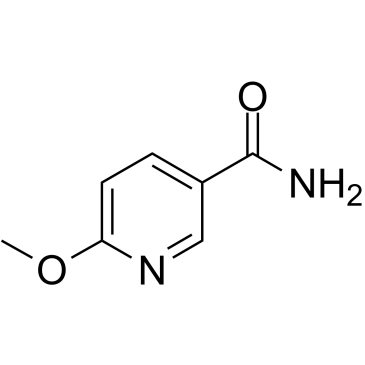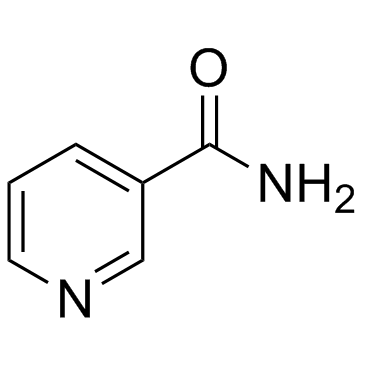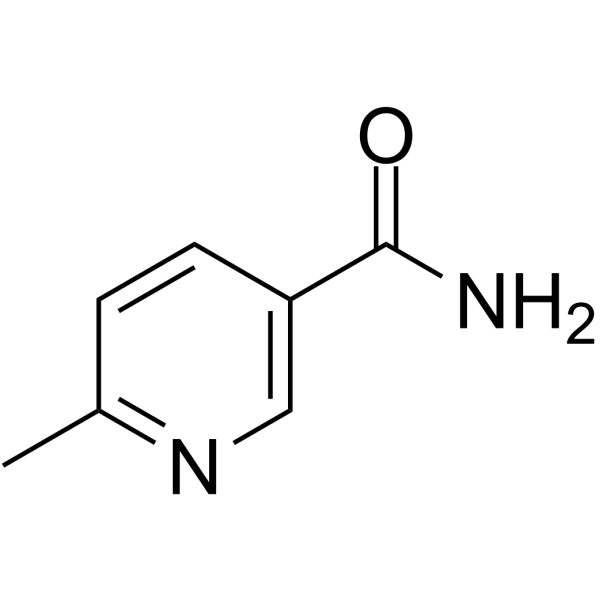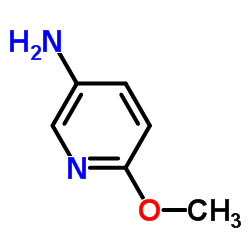7150-23-4
| Name | 6-Methoxynicotinamide |
|---|---|
| Synonyms | 6-methoxypyridine-3-carboxamide |
| Description | JBSNF-000088 (6-Methoxynicotinamide), a analog of nicotinamide (NA), is a potent Nicotinamide N-methyltransferase (NNMT) inhibitor with IC50s of 1.8 µM, 2.8 µM, and 5.0 µM for human NNMT, monkey NNMT and mouse NNMT, respectively. JBSNF-000088 inhibits NNMT activity, reduces MNA levels and drives insulin sensitization, glucose modulation and body weight reduction in animal models of metabolic disease[1]. |
|---|---|
| Target |
IC50: 1.8 µM (human NNMT), 2.8 µM (monkey NNMT) and 5.0 µM (mouse NNMT)[1] |
| In Vitro | JBSNF-000088 (6-Methoxynicotinamide) has IC50 values are 1.6 and 6.3 µM for U2OS or differentiated 3T3L1 cells[1]. |
| In Vivo | JBSNF-000088 (6-Methoxynicotinamide) (50 mg/kg; oral route of administration for four weeks) shows statistically significant reduction in body weight (%) and leads to a statistically significant reduction in fed blood glucose on day 21[1]. JBSNF-000088 (50 mg/kg; oral gavage administration; twice daily for four weeks) leads to a statistically significant improvement in oral glucose tolerance on day 28 with glucose tolerance being normalized[1]. JBSNF-000088 (1 mg/kg; intravenous administration; for 4 hours) results in low plasma clearance of 21 mL/min▪kg and the volume of distribution at steady state of 0.7 L/kg, a very short plasma half-life of 0.5 hours upon intravenous administration[1]. JBSNF-000088 (10 mg/kg; oral gavage; for 4 hours) results in a Cmax of 3568 ng/mL with a Tmax value of 0.5 hours, indicating rapid absorption in the intestine, and half-life of 0.4 hours by oral gavage. The oral bioavailability is found to be approximately 40%[1]. Animal Model: Mice with high fat diet (HFD)-induced obesity[1] Dosage: 50 mg/kg Administration: Oral route of administration for four weeks; oral gavage administration and twice daily for four weeks Result: Showed statistically significant reduction in body weight (%) and led to a statistically significant reduction in fed blood glucose on day 21 by oral route of administration. Led to a statistically significant improvement in oral glucose tolerance on day 28 with glucose tolerance being normalized by oral gavage administration. Animal Model: C57BL/6 mice[1] Dosage: 1 mg/kg (Intravenous administration);10 mg/kg (oral gavage)(Pharmacokinetic Study) Administration: Intravenous administration and oral gavage; for 4 hours Result: Resulted in low plasma clearance of 21 mL/min▪kg and the volume of distribution at steady state of 0.7 L/kg, a very short plasma half-life of 0.5 h upon intravenous administration. Resulted in a Cmax of 3568 ng/mL with a Tmax value of 0.5 hours, indicating rapid absorption in the intestine, and half-life of 0.4 hours by oral gavage. |
| References |
| Density | 1.213g/cm3 |
|---|---|
| Boiling Point | 301.6ºC at 760mmHg |
| Molecular Formula | C7H8N2O2 |
| Molecular Weight | 152.15100 |
| Flash Point | 136.2ºC |
| Exact Mass | 152.05900 |
| PSA | 65.21000 |
| LogP | 0.88940 |
| Index of Refraction | 1.55 |
|
Material Safety Data Sheet
Section1. Identification of the substance Product Name: 6-Methoxynicotinamide Synonyms: Section2. Hazards identification Harmful by inhalation, in contact with skin, and if swallowed. Section3. Composition/information on ingredients. Ingredient name:6-Methoxynicotinamide CAS number:7150-23-4 Section4. First aid measures Skin contact:Immediately wash skin with copious amounts of water for at least 15 minutes while removing contaminated clothing and shoes. If irritation persists, seek medical attention. Eye contact:Immediately wash skin with copious amounts of water for at least 15 minutes. Assure adequate flushing of the eyes by separating the eyelids with fingers. If irritation persists, seek medical attention. Inhalation:Remove to fresh air. In severe cases or if symptoms persist, seek medical attention. Ingestion:Wash out mouth with copious amounts of water for at least 15 minutes. Seek medical attention. Section5. Fire fighting measures In the event of a fire involving this material, alone or in combination with other materials, use dry powder or carbon dioxide extinguishers. Protective clothing and self-contained breathing apparatus should be worn. Section6. Accidental release measures Personal precautions: Wear suitable personal protective equipment which performs satisfactorily and meets local/state/national standards. Respiratory precaution:Wear approved mask/respirator Hand precaution:Wear suitable gloves/gauntlets Skin protection:Wear suitable protective clothing Eye protection:Wear suitable eye protection Methods for cleaning up: Mix with sand or similar inert absorbent material, sweep up and keep in a tightly closed container for disposal. See section 12. Environmental precautions: Do not allow material to enter drains or water courses. Section7. Handling and storage Handling:This product should be handled only by, or under the close supervision of, those properly qualified in the handling and use of potentially hazardous chemicals, who should take into account the fire, health and chemical hazard data given on this sheet. Store in closed vessels. Storage: Section8. Exposure Controls / Personal protection Engineering Controls: Use only in a chemical fume hood. Personal protective equipment: Wear laboratory clothing, chemical-resistant gloves and safety goggles. General hydiene measures: Wash thoroughly after handling. Wash contaminated clothing before reuse. Section9. Physical and chemical properties Appearance:Not specified Boiling point:No data No data Melting point: Flash point:No data Density:No data Molecular formula:C7H8N2O2 Molecular weight:152.2 Section10. Stability and reactivity Conditions to avoid: Heat, flames and sparks. Materials to avoid: Oxidizing agents. Possible hazardous combustion products: Carbon monoxide, nitrogen oxides. Section11. Toxicological information No data. Section12. Ecological information No data. Section13. Disposal consideration Arrange disposal as special waste, by licensed disposal company, in consultation with local waste disposal authority, in accordance with national and regional regulations. Section14. Transportation information Non-harzardous for air and ground transportation. Section15. Regulatory information No chemicals in this material are subject to the reporting requirements of SARA Title III, Section 302, or have known CAS numbers that exceed the threshold reporting levels established by SARA Title III, Section 313. SECTION 16 - ADDITIONAL INFORMATION N/A |
| HS Code | 2933399090 |
|---|
|
~2%
Detail
|
| Literature: Sugimori, Akira; Itoh, Hiroshi; Kanai, Mitsuharu; Itoh, Nobuko; Sugiyama, Toru Bulletin of the Chemical Society of Japan, 1988 , vol. 61, # 8 p. 2837 - 2846 |
| HS Code | 2933399090 |
|---|---|
| Summary | 2933399090. other compounds containing an unfused pyridine ring (whether or not hydrogenated) in the structure. VAT:17.0%. Tax rebate rate:13.0%. . MFN tariff:6.5%. General tariff:20.0% |





